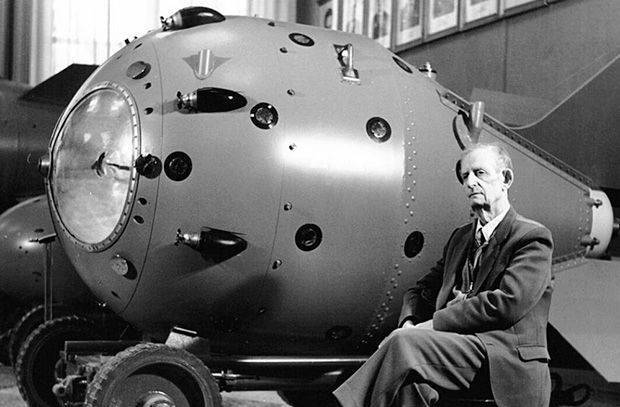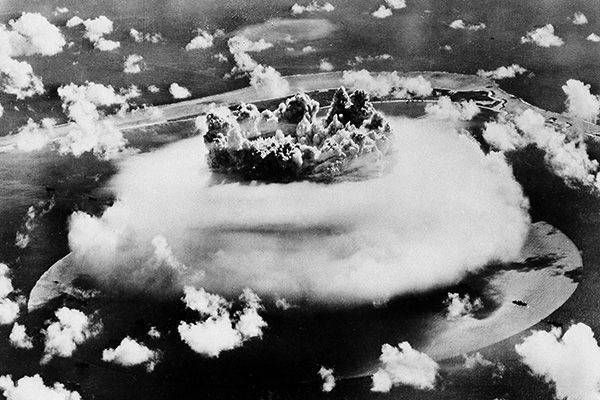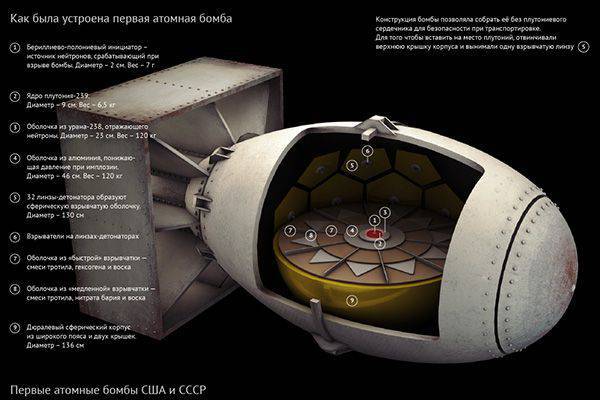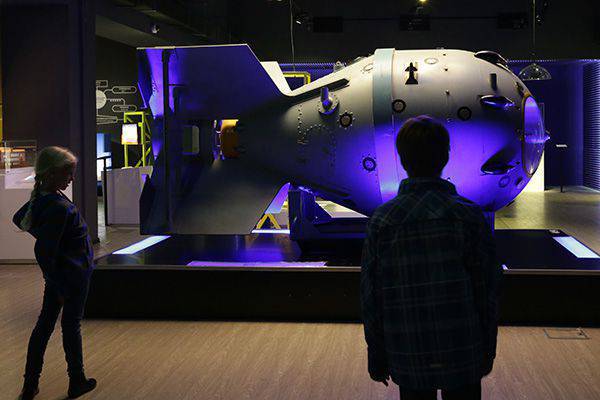How the first nuclear bomb appeared in the USSR

Under what conditions and with what efforts did the country that survived the most terrible war of the twentieth century create its atomic shield
Almost seven decades ago, on October 29 of 1949, the Presidium of the Supreme Soviet of the USSR issued four top-secret decrees awarding 845 people the titles of Heroes of Socialist Labor, the Orders of Lenin, the Red Banner of Labor, and the Badge of Honor. None of them did not say in relation to any of the recipients, for which he was marked: everywhere there was a standard wording "for exceptional services to the state when performing a special task." Even for those accustomed to the secrecy of the Soviet Union, this was a rare occurrence. Meanwhile, the award recipients themselves knew perfectly well, of course, what kind of “exceptional merit” they have in mind. All 845 people were more or less directly connected with the creation of the first USSR nuclear bomb.
For the recipients it was not strange that the project itself, and its success envelops a dense veil of secrecy. After all, they all knew well that they owed their success to the courage and professionalism of Soviet intelligence officers, who for eight years supplied scientists and engineers with top-secret information from abroad. And such a high estimate, which the creators of the Soviet atomic bomb deserve, was not exaggerated. As one of the bomb makers, academician Yuli Khariton, recalled, at the ceremony, Stalin suddenly said: "If we were late for one or one and a half years, then, probably, we would have tried this charge on ourselves." And this is not an exaggeration ...
Atomic bomb sample ... 1940 of the year
The idea of creating a bomb that uses the energy of a chain nuclear reaction in the Soviet Union came almost simultaneously with Germany and the United States. The first officially considered project of this type of weapons was presented in 1940 by a group of scientists from the Kharkov Institute of Physics and Technology under the leadership of Friedrich Lange. It was in this project for the first time in the USSR that the scheme for the detonation of conventional explosives, which later became a classic for all nuclear weapons, was proposed, due to which the subcritical is almost instantly formed from two subcritical masses of uranium.
The project received negative reviews and was not considered further. But the work laid at its foundation continued, and not only in Kharkov. Atomic themes in the pre-war USSR were occupied by at least four large institutes - in Leningrad, Kharkov and Moscow, and the chairman of the Council of People's Commissars Vyacheslav Molotov supervised the work. Soon after the submission of the Lange project, in January of 1941, the Soviet government made a logical decision to classify domestic atomic research. It was clear that they could indeed lead to the creation of a new type of powerful weaponsBut one shouldn't scatter such information, all the more so since it was at this time that the first intelligence on the American atomic project was received — and they did not want to risk theirs in Moscow.
The natural course of events interrupted the outbreak of World War II. But, despite the fact that all Soviet industry and science were quickly transferred to the military rails and began to provide the army with the most urgent developments and inventions, there were also forces and means to continue the atomic project. Although not immediately. The resumption of research should be counted from the decision of the State Defense Committee from February 11 1943, which stipulated the beginning of practical work on the creation of an atomic bomb.
Project "Enormous"
By this time, Soviet foreign intelligence was already in full swing working on the extraction of information on the Enormous project - this was the name of the American atomic project in operational documents. The first informative data showing that the West is seriously engaged in the creation of uranium weapons came from the London residency in September, 1941. And at the end of the same year, it was reported from the same source that America and Great Britain agreed to coordinate the efforts of their scientists in the field of atomic energy research. In the conditions of war, this could only be interpreted in one way: the allies were working on the creation of atomic weapons. And in February, 1942, the intelligence agency received documentary evidence that in Germany they are actively engaged in the same.
As the efforts of Soviet scientists working on their own plans progressed, the work of intelligence to obtain information about the American and British atomic projects became more active. In December, 1942-s finally became clear that the US is clearly ahead of Britain in this area, and the main efforts were focused on data from overseas. In fact, every step taken by the participants in the Manhattan Project, as the work on creating an atomic bomb in the United States was called, was tightly controlled by Soviet intelligence. It is enough to say that the most detailed information about the device of the first real atomic bomb in Moscow was received less than two weeks after it was collected in America.
That is why the boastful message of the new US President Harry Truman, who decided to stun Stalin at the Potsdam Conference with a statement that America had unprecedented weapons of unprecedented destructive power, did not cause the reaction that the American was counting on. The Soviet leader calmly listened to him, nodded - and did not answer. Foreigners were convinced that Stalin simply did not understand anything. In fact, the head of the USSR sensibly assessed Truman’s words and on the same day in the evening demanded that Soviet specialists maximally speed up work on creating their own atomic bomb. But it was impossible to overtake America. In less than a month, the first atomic mushroom grew over Hiroshima, three days later - over Nagasaki. And over the Soviet Union hung the shadow of a new, atomic war, not with anyone, but with former allies.
Time forward!
Now, seventy years later, no one is surprised that the Soviet Union has received the much needed time to create its own super-bomb, despite sharply deteriorated relations with the ex-partners in the anti-Hitler coalition. After all, 5 March 1946 of the year, six months after the first atomic bombing, Winston Churchill's famous Fulton speech, which marked the beginning of the Cold War, sounded. But in the hot, according to Washington and its allies, it had to outgrow later - at the end of 1949. After all, as they hoped overseas, the USSR should not have gotten its own atomic weapon before the middle of 1950, and therefore there was nowhere to hurry.

From the height of today, it seems surprising that the date of commencement of the new world war coincides - more precisely, one of the dates of one of the main plans, Fleetwood - and the test date of the first Soviet nuclear bomb: 1949 year. But in reality, everything is logical. The foreign policy situation grew tense quickly, the former allies were talking sharper and sharper with each other. And in 1948, it became absolutely clear that Moscow and Washington, apparently, could not agree between themselves. From here, we need to count the time before the start of the new war: the year is the deadline for which the countries that have recently emerged from the colossal war can fully prepare for the new one, in addition to the state that bore the brunt of the Victory. Even the atomic monopoly did not give the United States the opportunity to shorten the period of preparation for war.
Foreign "accents" of the Soviet atomic bomb
All this is well understood and with us. Since 1945, all work related to the atomic project has sharply intensified. During the first two post-war years of the USSR, tormented by the war, having lost a large part of its industrial potential, it was possible to create a colossal nuclear industry from scratch. Future nuclear centers emerged, such as Chelyabinsk-40, Arzamas-16, Obninsk, large scientific institutes and production facilities were formed.
Not so long ago, a common point of view on history Soviet atomic project was this: they say, if not for intelligence, Soviet scientists would not be able to create any atomic bomb. In fact, everything was far from being as clear as the revisionists of Russian history tried to show. In fact, the data obtained by Soviet intelligence on the American atomic project allowed our scientists to avoid many of the mistakes that their American colleagues inevitably had to make ahead (which, we recall, the war did not seriously interfere with the work: the enemy did not invade the United States, several months, half the industry). In addition, intelligence data, of course, helped the Soviet specialists to evaluate the most advantageous designs and technical solutions that allowed them to assemble their more advanced atomic bomb.
And if we talk about the degree of foreign influence on the Soviet atomic project, then, rather, we need to recall several hundreds of German nuclear specialists who worked at two secret facilities near Sukhumi - in the prototype of the future Sukhumi Institute of Physics and Technology. Here they are really very much to advance the work on the "product" - the first atomic bomb of the USSR, and so much that many of them with the same secret decrees from October 29 1949, were awarded Soviet orders. Most of these specialists five years later went back to Germany, settling for the most part in the GDR (although there were those who went to the West).
Objectively speaking, the first Soviet atomic bomb had, if I may say so, more than one “accent”. After all, she was born as a result of the colossal cooperation of the efforts of many people - both those who were involved in the project at will, and those who were attracted to work as prisoners of war or interned specialists. But the country, which by all means was required to get a weapon as soon as possible, equalizing its chances with the ex-allies, who were rapidly turning into mortal enemies, was not in the mood for sentiment.

Russia makes herself!
In the documents relating to the creation of the first nuclear bomb of the USSR, the term “product” later became popular. More often, it was officially called the “special jet engine,” or abbreviated RDS. Although, of course, nothing reactive in the work on this design and did not smell: the whole thing was only in the strictest requirements of secrecy.
Thanks to academician Yuli Khariton, the RDS abbreviation was very quickly fixed by the unofficial decryption “Russia makes itself”. There was a considerable share of irony in this, because everyone knew how much intelligence information they had obtained for our atomic scientists, but also a large amount of truth. After all, if the design of the first Soviet nuclear bomb was very similar to the American one (simply because the most optimal was chosen, and the laws of physics and mathematics do not have national characteristics), then, say, the ballistic body and the electronic filling of the first bomb were a purely domestic development.
When work on the Soviet atomic project advanced far enough, the leadership of the USSR formulated tactical and technical requirements for the first atomic bombs. It was decided to simultaneously refine two types: the plutonium bomb of the implosive type and the uranium bomb - a cannon similar to that used by the Americans. The first received the RDS-1 index, the second, respectively, the RDS-2.
According to the plan, RDS-1 was supposed to be submitted for state tests by an explosion in January 1948. But it was not possible to withstand these deadlines: there were problems with the manufacture and processing of the required amount of weapons-grade plutonium for its equipment. It was received only a year and a half later, in August, 1949-th - and immediately went to Arzamas-16, where the first Soviet atomic bomb was almost ready. Within a few days, the specialists of the future VNIIEF completed the assembly of the “product”, and it went to the Semipalatinsk test site for testing.
The first rivet of the nuclear shield of Russia
The first USSR nuclear bomb was detonated at seven in the morning on August 29 1949. Almost a month passed before the overseas got away from the shock caused by the intelligence about the successful testing in our country of their own “big stick”. Only 23 of September, Harry Truman, who had so recently boastfully informed Stalin about the successes of America in creating atomic weapons, made a statement that the same type of weapons are now also available in the USSR.

Strangely enough, in Moscow they were in no hurry to confirm the statements of the Americans. On the contrary, TASS has actually made a refutation of the American statement, arguing that the whole thing is in the enormous scale of construction in the USSR, in which explosive works with the use of the latest technologies are used. True, at the end of the Tass statement, there was a more than transparent hint at the possession of its own nuclear weapons. The agency reminded everyone that 6 was still on November 1947, USSR Foreign Minister Vyacheslav Molotov said that no secret of the atomic bomb has long existed.
And it was twice true. By the 1947, for the USSR, no information about atomic weapons was already a secret, and by the end of the summer, 1949 had no secret for anyone that the Soviet Union had restored strategic parity with its main rival, the United States. Parity, which has been preserved for six decades. A parity that the nuclear shield of Russia helps to maintain and which began on the eve of the Great Patriotic War.
Information